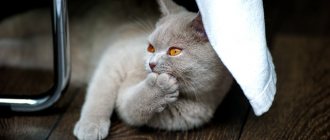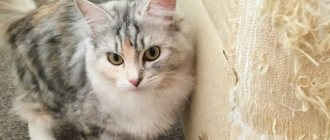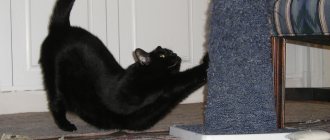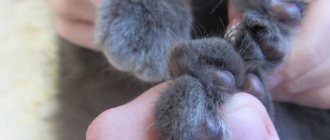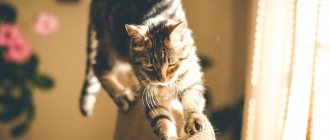Why does a cat tear up furniture?
The habit of sharpening their claws is formed in cats at the level of instincts under the influence of physiological, behavioral and psychological factors:
- The claws are constantly growing, the cornea is renewed, the old layer is peeled off, and cats clean it off on surrounding objects. This procedure keeps the nails sharp and healthy. Wild and barn cats use tree trunks, domestic animals use furniture, carpets, and walls.
- Cats use their paws to mark their territory: glands between the toes and on the pads secrete a secret with the individual scent of the animal.
- Kittens are raised by a cat for the first 3 months; if animals are separated from their mother early, they do not learn the basics of correct behavior, in the future they cannot be trained, and they do not recognize the scratching post.
- Sharpening claws for cats is a way to relieve psychological stress, throw out emotions, and express dissatisfaction. They use their paws more intensively when the situation changes, there is a lack of attention or a long absence of family members, or when a new animal appears in the house.
The owner will not eradicate the habit of sharpening his claws, but will be able to correct the pet’s behavior if he understands and solves his psychological problems.
Why do cats do this?
A cat does not tear up furniture because it wants to annoy its owners. Even 2-3 thousand years ago, cats were wild animals and, after domestication, retained the hunting skills and instincts necessary for survival in nature. The habit of tearing up furniture for cats has several meanings:
- exercise - during scratching, the muscles of the paws and back tense, as if stretching, and then relax. This “gymnastics” allows animals to constantly be in good shape;
- protection of territory - on the pads of cats' paws there are glands that secrete a sharp-smelling secretion when releasing their claws. Any stranger cat, sniffing the tattered furniture, will understand: there is already an owner in the house, plus he will see the size of the “rival” in terms of the height of the scratches;
- manicure for cats there is no difference between wood and an expensive sideboard. All this is great for sharpening claws. All feline predators have claws that grow throughout their lives and, if they are not ground down, begin to curl into rings, digging into the delicate skin of the paws. Scratching dense, but not too hard objects allows you to keep the claws in the desired shape. In the process, they are cleaned of dirt, dying scales, and become sharper (this is especially important for those cats that were taken into the house as living mousetraps).
You can demand that the cat not tear up the furniture only by offering him an adequate replacement - a comfortable scratching post.
Most often, damaging furniture for a cat is a kind of exercise
A convenient scratching post will help preserve furniture and wallpaper
In the article I will answer the question: why do cats tear up sofas and other furniture, tear wallpaper and jump on walls? I’ll tell you what methods you can use to stop doing this and give advice on what to do if none of the methods helps.
The answer to this question lies in the nature of the cat family. Any cat has a set of instincts that it has preserved and displays at home. Why do cats scratch furniture and wallpaper? Let's look further.
There are glands near the pads of a cat's front paws. By scratching a suitable surface, the cat stimulates them to release an odor that is imperceptible to the human sense of smell, but noticeable to cats. In addition, a visual mark is used - scratches.
The renewal of the stratum corneum of a cat's claw occurs by shedding its top layer. To do this, the cat chews it off or gets rid of it with the help of the owner's favorite carpet.
By tearing up wallpaper, cats sharpen their claws.
By scratching furniture and carpets, the cat stretches its muscles, stretches, and trains its claw retraction mechanism. This is exercise for the cat.
By scratching surfaces, the animal relieves nervous tension. If the situation in the house is tense, cats often scratch wallpaper and furniture.
Kittens also scratch objects that interest them. Most often, they do this for informational purposes. Tactile sensations help the kitten explore the object and its properties. Juveniles may scratch furniture as they play, clinging cheerfully to them like a wild cat.
There is no topical video for this article.
| Video (click to play). |
Weaning a cat from damaging property involves replacing the favorite scratching object with a similar material. You won't be able to stop scratching forever. This procedure is vital for a cat.
This method is universal and suitable for animals of any age. A scratching post is an object covered with fabric or sisal. It can be a flat board, cone, wave, column or other shapes. You can find a scratching post at any pet store.
The variety of shapes, materials and colors will help you choose a scratching post for any design and for any picky person with a mustache. There is a more interesting option - a play complex, which consists of houses with scratching posts connected to each other.
When buying a gaming complex for a cat, they provide it with a place to warm up, play, relax and sharpen its claws. Models are also multi-tiered, up to the ceiling. The happy owners of such houses do not worry about the safety of their furniture.
Cats have a keen sense of smell and cannot tolerate strong odors. If you apply such a scent to a surface chosen by a cat, there is a chance that the cat will lose interest in it. The main thing is that the smell does not irritate a person and does not stain the upholstery.
You can buy the finished spray at a pet store or prepare it yourself. The latter option is made from an infusion of spices, as well as a mixture of water and citrus essential oil.
Another type of spray contains cat enzymes. This composition leaves an odor similar to the smell of secretions secreted by cats. Having felt this smell, the cat decides that it has already marked this place and, perhaps, will refuse to scratch it.
The spray can be purchased at any pet store
A popular method is to scare the cat away from its favorite place. To do this, use any slippery, rustling and sticky materials. For example, attach foil or double-sided tape to the torn area. For these purposes, a sticky transparent film was invented, which is purchased at a pet store.
Another method is negative consequence. Its essence is to create a frightening noise during the scratching process. When the cat starts scratching, a bunch of keys or a baby rattle falls next to him. The main thing is that the cat does not see how the owner throws the thing.
You can attach clinging material to a torn wall
We suggest you read: How to wean a cat from bad habits
Another option for negative reinforcement is to spray water from a spray bottle or children's water pistol. Only this punishment must be carried out at the time of the offense, but not later.
You can buy special claw covers at the pet store. These things are attached to the top of the claw with glue and fall off with it about once a month. False claws are harmless to cats and do not interfere with the ability to retract their claws freely. They usually have bright colors and special glue included.
Claw stickers
- The scratching post is placed in a favorite place for scratching. For example, they move it towards furniture or put it against scratched wallpaper. When the cat learns to scratch it, the scratching post is gradually moved to the place desired by the owner.
- They show what needs to be done. To show how to use a scratching post, they pretend to scratch it with their hands. They try to scratch it with the cat's paws. Another interesting option involves moving the toy along the scratching post so that the cat clings to it with its paws.
If the cat shows interest in the scratching post, it is encouraged - petted and given a treat. If the cat does not show interest in it, it is confused by the smell of the item or its material.
Leads to the cat’s loss of confidence and the development of neurosis. In this case, the animal will spoil things in the absence of the owners in order to avoid punishment.
Leads to the above consequences and increases the risk of injury to the animal.
There is a risk of allergies and poisoning for both people and animals. In addition, you can ruin the upholstery.
Mint attracts cats and has an intoxicating effect. Instead of using the scratching post for its intended purpose, the animal will rub against it and roll on the floor.
Cats are picky pets. If the cat doesn't like the scratching post, he won't use it. You can reduce the damage caused by cat claws using the following methods:
- Trim the claws on the front paws (only the tip free from the vessel is cut off);
- Place removable covers on furniture;
- Install different types of scratching posts in different rooms;
- Move furniture so as to make it difficult to reach the favorite scratching spot;
- Make renovations “for pets”;
- Eliminate access to the room where the cat scratches;
The abundance of methods presented creates comprehensive protection for property from cat claws. If one method is not suitable, use another.
If the apartment has expensive furniture and decoration, and the cat is not allowed to run and frolic, it is better to find her another home. The presence of animals in the home always implies some damage. Animals are raised from an early age, using only non-violent methods.
How to protect your apartment from cat claws
To preserve the home interior, the cat's claws are regularly trimmed: after the procedure, he scratches things less and sometimes temporarily stops sharpening his claws. The cat's attention is switched from the upholstery and wallpaper to the scratching posts; they are placed next to the places of damage and are firmly fixed. The cat will not use a structure that wobbles and tends to fall.
The kitten gets used to the new place for its claws faster; the older the pet, the more difficult it is to re-educate it. While accustoming a cat to a scratching post, owners at the same time find ways to keep the interior of the apartment unharmed.
Weaning with a scratching post
Wallpaper and furniture for a cat are an excellent simulator for sharpening claws. They can only be replaced with a properly selected claw sharpener. Moreover, any such item, be it a product specially designed for pet stores or just a piece of board, must meet a number of requirements:
- The height or length of the claw sharpener must exceed the height of the animal with outstretched paws. You can measure this distance by luring the cat with a treat and seeing where it reaches, standing on its hind legs;
- the surface should be hard, but not too hard, rather reminiscent of the texture of tree bark. Hard wood, metal and plastic are not suitable for this purpose. The ideal option is wooden objects covered in several layers of hemp, jute rope or thick sackcloth;
- The outer covering of the scratching post must be made of natural materials, otherwise the pet may be poisoned when licking.
We invite you to familiarize yourself with: Castration of bulls, a bloodless method of castration
Now there are many options for scratching posts: posts, mats, inclined and horizontal boards. They produce entire complexes where the scratching post is equipped with a sleeping basket and a play area with many toys. You need to choose a scratching post according to the height and weight of the animal. The larger the animal, the higher and more stable the claw sharpening object should be.
It’s easy to make a pet cattery with your own hands. It is enough to wrap an object of suitable length with a rope. Thick natural fabric is well suited as a covering: tarpaulin, burlap, jeans.
Observe the animal and find out how it most often sharpens its claws: standing on its hind legs or arching its back on a horizontal surface? The choice of scratching post will depend on this. Determine where your pet sharpens its claws most often and place a scratching post in that location. If there are a lot of scratched items and they all have different locations, it is better to place several “manicure sets” in several places. There should be at least one thing in every room that a cat can scratch its claws on.
Many cats combine sharpening their claws with stretching. As a rule, they do this after sleep to tone their muscles. In this case, it is better to place the scratching post next to the cat's bed. Then the animal will tear the thing intended for this purpose, and not the expensive carpet.
The best way to stop a cat from scratching the sofa is with a scratching post. You can buy it at any pet store. There is a huge range of such designs. However, you won’t be able to simply buy and place a scratching post in front of your cat. It will take some effort to train him to sharpen his claws on it.
To accustom the animal to this device, you should place it exactly in the place where the cat scratches the furniture. Place his paws on the scratching post and show with movements that you need to sharpen your claws on it. This must be done several times so that the pet understands what they want from him.
Most cats do not want to get used to this design. In this case, you will have to try other methods.
Repellent and attractive odors
To correct behavior, pet stores sell sprays with scents that are repulsive and attractive to cats. Repellents include safe components: essential oils of citrus fruits, spices, black pepper extract, wormwood, capsaicin - a component of capsicum with a bitter taste. They do not leave stains and the smell is tolerable to the human nose.
Spray the areas that the cat has chosen for sharpening its claws. Apply to electrical wires if they cannot be hidden, and the pet stubbornly chews. The smell disappears quickly, it is renewed once a day.
At the same time, the scratching posts are sprayed with a spray with attractive aromas: valerian, catnip, enzymes. These smells attract and calm cats.
Sprays to protect furniture and attract cats are produced by the following companies:
- Api-San;
- Best friend;
- Biovax;
- AnimAll;
- Mr. Fresh;
- Beaphar;
- Doctor Vic;
- Trixie.
If there is no spray, use aromatic oils of orange, grapefruit, lemon. They are added to water, sprayed on walls, upholstery, and carpets. After treatment, animals avoid sources of unpleasant odors, stretch and get used to the scratching post faster.
How to stop a kitten from jumping on curtains
Kitten doesn't want to go to the litter box
How to stop a cat from chewing wires
Education and training
A cat should not be physically punished for damaging things. Sharpening her claws is a natural behavior for her. The animal will not understand what it has done wrong and will see the owner as an enemy.
Cats are able to grasp cause-and-effect relationships, so to correct their behavior they develop conditioned reflexes:
- After each approach to the scratching post, the pet is encouraged: praised, petted, treated with delicious food.
- Cats cannot tolerate harsh sounds. When trying to scratch furniture, they suddenly clap their hands or knock with metal objects.
- A tin can with coins inside is placed nearby: if the cat touches it, it falls with a roar and scares away the animal.
- At the moment of committing an offense, the pet is sprayed with a stream of water from a spray bottle.
- At the same time, they are taught the prohibitory words “No”, “Ugh”, “No”. Commands are pronounced loudly, with confident intonation.
After these steps, the cat is taken to the scratching post and carefully scraped with its paws along the surface. Educational measures produce results if they are repeated systematically.
Protective coatings
Prudent owners think in advance about how to protect walls, floors, and upholstery from scratches:
- Clean cats do not like sticky surfaces and will not touch them with their paws. Table legs, armrests, and edges of window sills are covered with double-sided tape. To protect against scratches, adhesive tapes are produced. Sticky Paws - they are invisible, adhere firmly to fabric surfaces, and do not leave marks.
- Upholstered furniture is covered with covers made of strong, scratch-resistant fabric; they are easier to clean and replace than a sofa or armchair.
- During repairs, the walls are covered with durable, smooth wallpaper: vinyl, paintable, liquid, fiberglass. The corners are covered with plastic panels; they are easier to replace than to re-glue the walls. Cats are not interested in decorative plaster, ceramic tiles, linoleum, or durable laminate.
- The areas where the cat is targeting are temporarily covered with aluminum foil: animals do not like smooth sliding surfaces. Cats do not like packaging film with air bubbles; their claws sink into it and get stuck.
Repellent sprays with a motion sensor have appeared on sale. When cats approach, they make a sound or release a stream of air or water. This remedy is not used for animals with unstable psyches.
Claw pads
“Soft Claws” Soft Claws are sold in pet stores; these are elastic caps for gluing to claws. There are nozzles in four sizes depending on the weight of the cat, translucent and colored; they are made from silicone, soft plastic or rubber. The caps last 4–6 weeks, then fall off along with the old keratinized membrane. The animal’s paws do not hurt or itch: the attachments do not touch the pads, they are glued half a centimeter before the base of the claw, and there are no nerve receptors in the horny part.
During the first three days, cats get used to unusual tactile sensations: they chew their paws, try to get rid of caps, and move uncertainly. Then the previous behavior and gait return. Cats freely extend and retract their claws and continue to scratch furniture, but leave no damage. The surface of the cap is smooth; if accidentally swallowed, it does not get stuck in the gastrointestinal tract, moves freely through the intestines and is released with feces.
The attachments are only applied to stay-at-home cats; they are deadly for free-ranging animals. Without sharp claws, a pet will not be able to fight back other cats, will not climb a tree trunk and will not hide from the dog. The pads are removed when redness, swelling, and irritation are noticed on the paws; these are signs of individual intolerance to the material of the caps or glue. Use attachments carefully if your pet loves heights. When jumping, the cat has nothing to catch on; he risks falling and getting injured.
A universal method for protecting the interior of the house from cat scratches has not been invented. The owner will need time, patience and imagination to find an approach to the pet.
If the animal is not retrained
Before you stop your cat from scratching furniture, you need to understand why the cat does it here. There can be many reasons for this:
- the material of upholstery or wallpaper is most convenient for claws (this is easy to check by covering the “problem area” with a fabric of a different density);
- the height and location of the object allows the cat to stretch comfortably (try rearranging the object and see if the animal continues to scratch it);
- the object turned out to be closest to the place where the animal feels the urge to stretch - for example, after waking up;
- if a cat scratches the furniture on which the owner usually sits, this may be a manifestation of sympathy or a desire to be closer to the person (in this case, it is often enough to install a scratching post closer to your favorite chair or sofa).
Ragged corners can be covered
scratching post
Anti-claw material
There are many ways to stop a cat from scratching furniture. The choice of method depends on the animal’s age, habits, and breed. Maine Coons generally prefer to scratch vertical surfaces and, if you buy them a rug, will continue to scratch their claws on cabinets and sofas. Siamese cats have such a stubborn, vindictive character that at the slightest cruelty on the part of their owners, they will begin to spoil things out of spite.
To prevent your cat from scratching the furniture, offer her an object that is convenient for sharpening her claws, and firmly stop all attempts to encroach on the furniture. Be patient: it sometimes takes up to 2-3 months to develop a positive habit. There are a few simple steps to follow:
- Place the scratching post in the chosen location. For the first day, do not force the cat to approach her. Let her get used to the unfamiliar thing. To make the process go faster, you can hang some clothes on the scratching post that retain the scent of your beloved owner. This way the cat will quickly understand that the new piece of furniture does not pose a threat;
- bring the animal to the nail clipper and, bending your fingers, scratch it with your nails, showing what this item is for;
- Place the cat's paws on the scratching post, apply a little pressure so that the claws protrude from the pads, and force the animal to make several characteristic movements. Be careful: cats do not like coercion, and at the slightest resistance the pet must be released;
- as soon as the animal does what is required of it, caress it and treat it with something tasty;
- every time your pet is about to tear up the furniture, shout sternly at him or lightly spank him on the ears: this is harmless, but very unpleasant;
- Hang your pet’s favorite toy on the cat post so that it dangles freely. Most predators, having gotten caught in an attempt to catch a toy with their claws, begin to sharpen them, after which they quickly realize that doing this here is more convenient than on the armrest of a chair.
We invite you to familiarize yourself with: How to build a rabbitry with your own hands: dimensions and drawings, diagrams, how to make ventilation, flooring, how to disinfect, photos, videos
There are several tricks to speed up the education process. If the cat ignores the scratching post, you can sprinkle it with catnip or sprinkle it with an infusion of this herb: this smell is pleasant to the animals, which means they will spend more time at their manicure device.
You can discourage your cat from tearing up wallpaper and furniture using water. Prepare a spray bottle and, when the animal settles down to sharpen its claws in the wrong place, spray it in the face. Immediately after this, you need to pick him up, put him on the scratching post and caress him. The conditioned reflex “unpleasant-impossible” and “pleasant-possible” should take hold. For many animals, 3-4 times are enough to remember that you can’t tear up furniture.
If your cat is tearing up the wallpaper, hang a thick wicker rug on the wall in the problem area. Or, if your pet is attracted to the paper covering, make a scratching post for him yourself by gluing several layers of old wallpaper onto cardboard or a sheet of plywood.
It is better to teach a scratching post not when the cat has already begun to damage the furniture, but much earlier, so that later you do not have to think about how to wean the kitten from scratching sofas and wallpaper. The animal must get used to the fact that scratching its claws is only allowed on a scratching post. Kids easily get used to the rules that their owners set for them, but retraining an older kitten is very difficult.
Some people ignore scratching posts, using exclusively cabinets, cupboards and wallpaper to sharpen their claws. How to stop a cat from scratching furniture and wallpaper in this case:
- come to terms with your pet's habit;
- cover all “problem areas” with thick covers;
- buy several scratching posts and arrange them so that they completely cover the places that he is used to scratching;
- use a special aerosol spray that emits an unpleasant odor for cats. Such preparations as “Api-San”, “Bio Vax”, “Mr. Fresh." As a cheap alternative to a branded spray, lemon juice, onion triple cologne - in short, any other substances that repel cats;
- buy special pads for the paws. They are made of silicone and are dense caps that stick to the claws. They are used both to save expensive furniture from scratches and to protect animal claws. Cats often cling to soft upholstery and injure their paws in an attempt to free themselves;
- and the most barbaric and inhumane method: a surgical operation during which the cat’s claws along with the pads of the fingers will be removed. This will protect furniture and wallpaper with a 100% guarantee. But after this the animal will become disabled and will constantly experience torment.
Anti-scratch
Claw stickers
